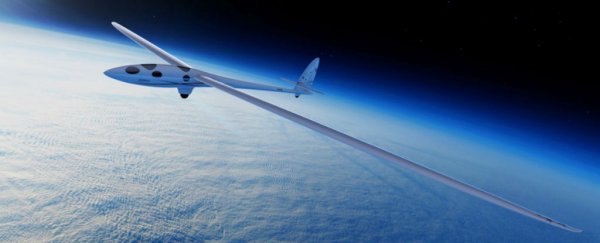Airbus is getting ready to test the capacity of its engineless Perlan 2 glider, and it's expected to reach an altitude of 27 km (90,000 feet) - well beyond the lower edge of Earth's stratosphere. If it succeeds, this will be the highest any winged vehicle, powered or otherwise, has achieved sustained, level flight.
While that would be a pretty awesome achievement in itself, if Airbus sets this record, it could have really exciting implications for the future of aviation not only on Earth, but also out on Mars. "Airbus recently filed a patent for hypersonic passenger craft that will go to suborbital space and back down again," Allan McArtor, chairman and CEO of Airbus, told Forbes. "It's in that region of suborbital space that Perlan 2 will be flying."
Back in 2012, pilots Steve Fossett and Einar Enevoldson crushed the existing altitude record for gliders by hitting an altitude of 15.4 km (50,671 feet) in Airbus's Perlan 1 glider. This aircraft has since entered retirement in the Seattle Museum of Flight, but we're about to see the difference four years of development can make.
While Fossett and Enevoldson (a former NASA test pilot who founded the Perlan Project) had to borrow special inflated pressure suits from NASA to survive such a thin atmosphere, the Perlan 2 crew will be in the (relative) lap of luxury inside its pressurised cabin, complete with oxygen re-breather systems.
So how does it hit such heights without an engine? Since the 1930s, pilots have been experimenting with mountain waves - strong oscillations caused by winds travelling at speeds of at least 27 km/h (15 knots) as they blow across the tops of mountains. For decades, glider pilots knew if they rode in the waves, rather than on top of them like a surfer, they could use the upward-moving part to hit much higher altitudes.
But there was a limit to how high they could get - or so they thought. Because of the interaction between cold air and warm air at the troposphere and the stratosphere, it was assumed that these mountain waves could only carry you to this point, so an altitude of about 9 km ( 30,000 ft) at the poles to 17 km (56,000 ft) at the Equator.
Then Enevoldson came along and changed everything. As Gary Robbins writes for the San Diego Union-Tribune:
"Einar Enevoldson was strolling past a scientist's office in 1991 when he noticed a freshly printed image tacked to the wall. He was thunderstruck; it showed faint particles in the sky that proved something he had long believed - the winds that rise off mountains travel far, far higher into the atmosphere than most people imagined, representing something of an 'elevator' to the heavens."
As a man of science, Enevoldson probably wouldn't have put it like that, but he spent the next seven years gathering evidence of mountain waves existence well into the stratosphere.
In 1998, meteorologist Elizabeth Austin started collaborating with Enevoldson, and discovered what would come to be known as the Polar Vortex - a stratospheric polar night jet that only occurs in winter when the air is super cold and travelling at speeds of around 480 km/h (260 knots) form incredibly high mountain waves. It's on these particular waves that the Perlan Project has been built.
The mission to get higher than any other winged vehicle ever has before is not just to test the limits of current aviation technology - Airbus says by getting an engineless glider up there, it will allow scientists to study the unique atmospheric conditions of the stratosphere's middle, without polluting everything in the process with fuel emissions.
Accordingly, the plane will be fitted with several scientific instruments for taking various atmospheric measures. "The knowledge gained from this project will impact how the world understands and addresses climate change," Airbus Group CEO, Tom Enders, said last year. "But it will also help Airbus continue to innovate ways to fly higher, faster and cleaner, on Earth and possibly beyond."
As Bruce Dorminey explains at Forbes, the more we know about the atmospheric conditions of the stratosphere, the better informed we'll be about what pilots stationed out on Mars will one day have to deal with:
"With Mars's thin atmosphere, McArtor says flight using a propeller or a standard turbine jet engine would be very difficult. Instead, he says that a Mars aircraft would need to be a hybrid that used some means of thrust and soar dynamics to move above the red planet's surface."
The Perlan 2 test flight is scheduled for June, and the glider will take-off from a base in Argentina, propelled a few thousand metres up using a tow plane and cable, and then catching mountain waves all the way up. By 2019, they hope to hit an altitude of 30 km (100,000 feet) using special transonic wings. It's going to be one hell of a flight.
